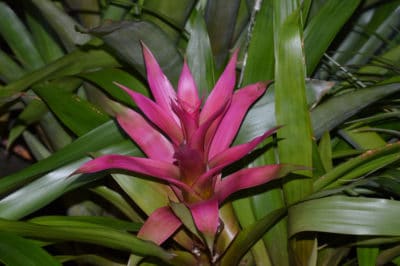Species Determines Fertilizer Needs
The huge number and diversity of bromeliads means a wide range of fertilizer requirements as well. Another factor is how the plants obtain nourishment. Epiphytic bromeliads like Spanish moss or air plants (Tillandsia), get much of their food from the air and rainwater. Some also get nutrients from decomposing insects that die on the plant. Terrestrial bromeliads like the pineapple absorb nutrients through their roots.
Timing Fertilizer
No matter what kind of plant you’re feeding, timing makes a difference. Bromeliads are active growers in spring and summer, then taper off in fall and become partially dormant in winter. Begin feeding in April and continue to feed until August, when you should taper feeding through the end of September. Water regularly during the feeding taper, then cut water by half after the final feeding.
Fertilizer Don’ts for Bromeliads
Some basic rules should be followed for all bromeliads. Among these:
- Avoid high nitrogen fertilizers if you want flowers.
- Don’t fertilize a dormant plant as it can burn the leaves.
- Never put solid fertilizer like pellets or powder into a bromeliad’s central cup; it can burn the plant.
- Don’t give any bromeliad full-strength fertilizer; diluted is safer and more effective.
Feeding Urn Plants and Earth Stars
Urn plants (Aechema) and earth stars (Cryptanthus) both do well with 20-20-20 NPK fertilizer. However, dilute to half strength for urn plants and apply to the central foliage rosette; water thoroughly. Feed cryptanthus with fertilizer diluted to quarter strength and pour it directly on the soil. Feed epiphytic urn plants by spraying twice weekly with one-eighth to one-sixteenth dilution of 20-20-20 NPK.
Feeding Blushing Bromeliads
Blushing bromeliads belong to the Neoregelia group. The flowers are insignificant, but the base of the leaves and plant center turn red when it is about to bloom. If you use 20-20-20 NPK fertilizer, dilute to one-sixteenth and feed only once a month. You can also use 5-59-10 NPK fertilizer diluted to one-eighth strength and feed once a week. Stop feeding if it begins to lose foliage color.
Feeding Other Bromeliads
Bilbergias are epiphytic bromeliads. They do best with a monthly feeding of 20-20-20 NPK at half strength during the growing season. Guzmanias can be fed with slow-release pellets added to the soil only. Tillandsias (air plants) should be treated like neoregelia if soft-leaved. Hard-leaved tillandsias need low-nitrogen fertilizer at one-quarter strength. Soak the plant occasionally.
